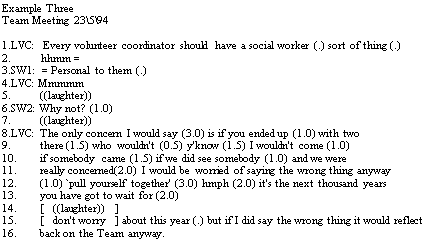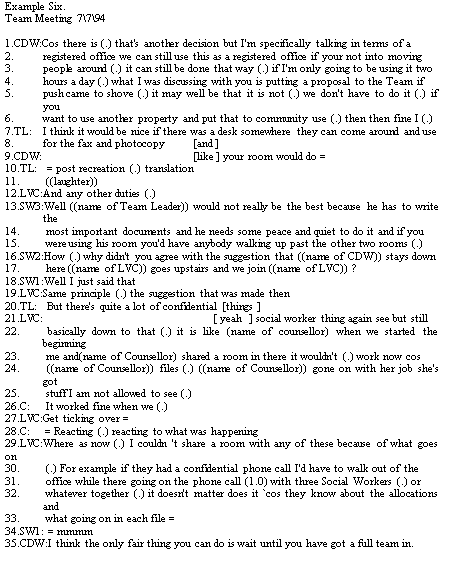
William Housley (1999)
'Role as an Interactional Device and Resource in Multidisciplinary Team
Meetings'
Sociological Research Online, vol. 4,
no. 3, <http://www.socresonline.org.uk/4/3/housley.html>
To cite articles published in Sociological Research Online, please reference the above information and include paragraph numbers if necessary
Received: 12/5/1999 Accepted: 17/9/1999 Published: 30/9/1999
 Abstract
Abstract Introduction
IntroductionRather than treating "role" as a self evident, social-scientific resource for analysis, and following the work by Garfinkel (1967) and Zimmerman and Pollner (1970), social scientists should take it as a topic of study. Doing so will help illuminate how interactants organize the social world by their use of these conceptions and actions.
Our recommendation is to view 'role' as an organising concept used on occasion by actors in social settings, and to view its utility for actors in terms of what they can do with it; i.e. the work they require it to do, in sustaining the perceived stability of social behaviour, whatever their immediate purposes. Viewed this way, roles are not behavioural matrices to be described and explained but are conceptual resources actors use to clear up confusion, sanction troublemakers, instruct others in the ways of the world, and so forth.
 Methodological approach to
the analysis of multidisciplinary team talk
Methodological approach to
the analysis of multidisciplinary team talk Conversation
Analysis
Conversation
Analysis
 Membership Categorisation
Analysis
Membership Categorisation
Analysis
If two or more categories are used to categorise two or more members of some population and those categories can be heard as categories from the same collection then: hear them that way.
 The Reconsidered Model of
Membership Categorization Analysis.
The Reconsidered Model of
Membership Categorization Analysis.
What I am claiming, then, is that interlocutors' sensible production and monitoring of an utterance and of a series of utterances is both categorical and sequential. Interlocutors' conjoint orientation to categorial relevancies informs their orientation to the 'structure' of utterance and series which in turn inform the categorial relevancies. In Aaron Cicourel's apt phrase, there is a 'folding back effect' on the utterance production and monitoring, a darting back and forth reflexive consultation of categorial and sequential relevances in order that utterance or series be rendered describable or identifiable as transacting this or that activity, as forming a component of this or that overall course of action and social setting.
Membership categorisation devices or collections are ... to be regarded as in situ achievements of members' practical actions and practical reasoning. Categories are 'collected' with others in the course of their being used. In turn, then, this means that the 'collection' to which a category belongs is constituted through its use in a particular context; it is part and parcel of its use in that way. Its recognisability is part of the phenomena itself. What 'collection' the category belong to, and what the collection is, are constituted in and how it is used this time.
 The Flood Support
Team
The Flood Support
Team
 Analysis
Analysis



 Role - Category Identity as a
Members' Phenomenon
Role - Category Identity as a
Members' Phenomenon

 Role as an Interactional \
Organisational Device and Resource
Role as an Interactional \
Organisational Device and Resource

 Conclusion
Conclusion
![]()
 Notes
Notes2The notion of recognisability and availability refers to the accountable features of members talk which are designed in terms of a reciprocity of perspective and as a means of mutually engaging in the activity of the meeting. The 'strong' form of recognisability can be understood in terms of direct reference to the categories or devices that is being topically oriented towards in talk whilst the 'weak' form of recognisability refers to predicate work (i.e. associations, attributions and activities) that refer, praxiologically, to a specific topic. For example, if the topic was the moral evaluation of an individual one might state 'I don't like him/her she/he is a bad person' (strong form of recognisability) or refer to the same person as being 'lazy', recount stories of their behaviour on previous occassions (they drank too much at the party) or suggest that their outwardly appearence conceals some form of dark motives (e.g. there eyes are to close together etc). In both cases these strategies can be used to do various types of work within occasioned settings including the 'formal' parameters of team meeting talk.
3In addition to these ideas Sacks (1972a) proposes a number of further membership categorisation analytic concepts. These include paired relational categories (e.g.mother / son and boyfriend / girlfriend), device 'R' that provides members with a means of identifying and searching for a particular category (e.g. having no one to turn to being tied to the category of being suicidal), programmatic relevance within which 'if R is relevant, then the non-incumbency of any of its pair positions is an observable, i.e. it can be proposedly a fact' (1972a:38) and collection K that is tied to the designation and identification of particular collections (e.g. professional knowledge etc.).
 Acknowledgements
Acknowledgements
BANTON, M. (1965). Roles: An Introduction to Social Relations. London, Tavistock Publications.
BERGER,P. and LUCKMANN,T. (1966). The Social Construction of Reality. London, Allen Lane.
BIDDLE, J. (1979). Role Theory; Concepts and Research. New York, Wiley.
DREW,P. and HERITAGE J. (1992). Talk at Work: Interaction in Institutional Settings. Cambridge, Cambridge University Press.
EGLIN, P. and HESTER, S. (1992). Category, Predicate and Task: The Pragmatics of Practical Action. Semiotica (8-3/4: 243-268).
GOFFMAN, E. (1961). Role Distance, Encounters. Indianapolis, Bobs Merrill.
HALKOWSKI, T (1990). Role as an Interactional Device. Social Problems (37:564 - 577)
HESTER,S. and EGLIN, P. (1997). Culture in Action: Studies in Membership Categorization Analysis. International Institute for Ethnomethodology and Conversation Analysis and University Press of America, Washington, D.C.
HESTER, S. (1994). Les Categories en Contexte. Raisons Pratiques 5:219-42. Special Issues title 'L'Entquite sur les Categories: de Durkheim et Sacks', (Ed.), B.Fradin, L. Quiro and J. Widmer. Editions de l'Ecole des Hautes Etudes en Sciences Sociales, Paris.
HESTER, S. and FRANCIS, D. (1994). Doing Data: The Local Organization of a Sociological Interview. British Journal of Sociology (45:4: 675-695)
HILBERT, E. (1981) in Halkowski, T. (1990) Role as an Interactional Device. Social problems. (37: 564 - 577.)
HOUSLEY, W. (1999). Category Work and Knowledgeability within Multidisciplinary Team Meetings. TEXT (in print).
LEVINSON, S. (1994). Pragmatics. Cambridge, Cambridge University Press.
LINTON, R. (1936). The Study of Man an Introduction. New York, Appleton Century Company.
MALINOWSKI, B. (1944). A Scientific Theory of Culture and other essays. New York, Chapel Hill.
ØVRETVEIT, J. (1994). Coordinating Community Care: Multidisciplinary Teams and Care Management. Buckingham, Open University Press.
PARSONS, T. (1951). The Social System. London, Tavistock.
SACKS, H. (1972a). An Initial Investigation of the Usability of Conversational Data for doing Sociology. In Sudnow, D. Studies in Social Interaction. New York, Free Press.
SACKS, H. (1972,b). On the Analyzability of Stories by Children. In J. Gumperz and D.Hymes (eds), Directions in Sociolinguistics (New York: Holt, Rinehart and Winston (pp.325 - 425).
SACKS, H. (1992a). Lectures on Conversation, Vol I. G.Jefferson (Ed.) with introduction by E.A.
SACKS, H. (1992b). Lectures on Conversation, Vol II. G. Jefferson (Ed.), with introduction by E.A. Schegloff. Oxford, Basil Blackwell.
SACKS, H. SCHEGLOFF, E.A. and JEFFERSON, G. (1974). A Simplest Systematics for the Organization of Turn Taking for Conversation. Language (50:697-735).
SILVERMAN, D. (1998). Harvey Sacks: Social Science and Conversation Analysis. Cambridge, Polity Press.
WATSON, D.R. (1997). Some General Reflections of Category and Sequence. In Hester and Eglin Culture in Action: Studies in Membership Categorization Analysis.International Institute for Ethnomethodology and Conversation Analysis and University Press of America, Washington, D.C.
WATSON, D.R. (1978). Categorisation, Authorisation and Blame Negotiation in Conversation. Sociology (12(1):105-13).
 Appendix
AppendixSW1: Social Worker One (Psychiatric Social Worker) SW2: Social Worker Two (Geriatric Social Worker) SW3: Social Worker Three C: Counsellor CDW: Community Development Worker TL: Team Leader LVC: Lay Volunteer Co-ordinator Sec: Secretary St: Student
Numbers in Parentheses: e.g. (1.0) denotes the approximate duration pauses or gaps between utterances in seconds or tenths of seconds.
Point in Parentheses: (.) indicates a 'micro - pause' of less than two tenths of a second
Letters, words or activities in parentheses: cough sounds, laughter words or activities that are distinct or difficult to locate to a particular interlocuter (s)
e.g. SW2: I think we've heard enough about what you think ((name of CDW)) ((laughter)) CDW Oh (.) okay thenSquare Brackets: [ ] mark the points where talk overlaps
e.g. SW1: I think that we should proceed with
[the pla::n ]
TL:
[I couldn't ] agree more
Full Colons: ( : : ) denote an extension in the vowel or consonant
sound in the utterance of a word
e.g. SW2: Tha::t's the oneEquals signs: ( = ) identifies a 'latching' between utterances, whereby which utterances follow each other rapidly after a preceding utterance.
e.g. C: I thought you were supposed
to be at the meeting =
LVC: = I was at the meeting
